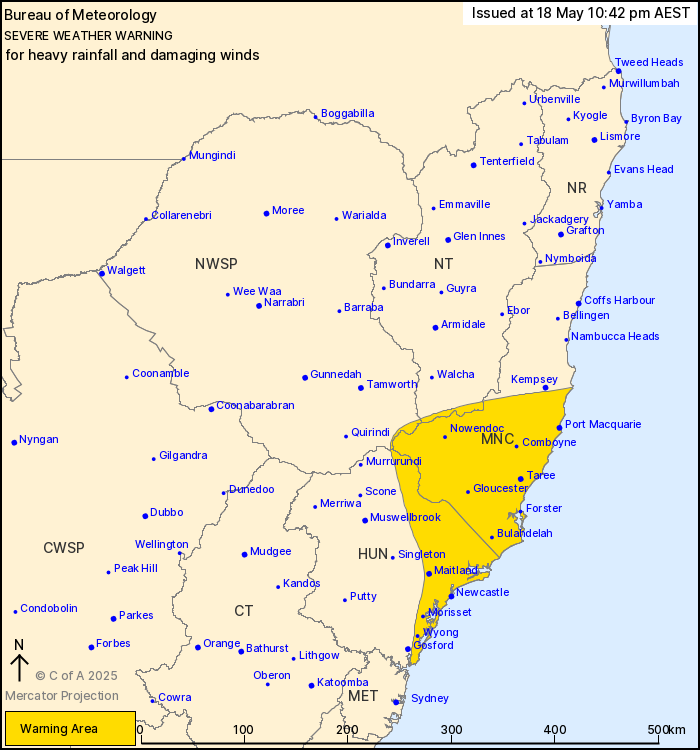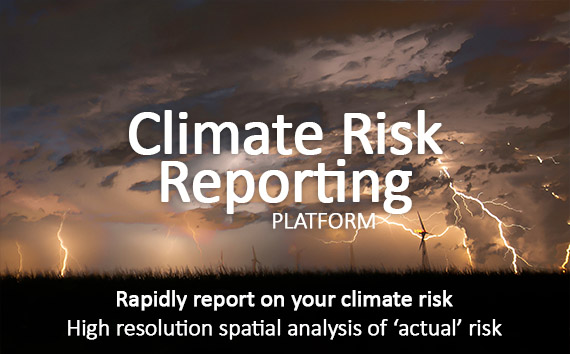Source: Bureau of Meteorology
For people in parts of Mid North Coast, Hunter, North West Slopes
and Plains and Northern Tablelands Forecast Districts.
Issued at 10:42 pm Sunday, 18 May 2025.
Heavy rainfall and damaging winds developing about the Hunter and
Mid North Coast.
Weather Situation: A coastal trough is forecast to deepen and
stall about the Mid North Coast and Hunter districts on Monday,
with persistent moderate to heavy rainfall expected in a moist
onshore flow through to Wednesday.
Prolonged moderate rainfall with isolated areas of HEAVY RAINFALL
which may lead to FLASH FLOODING is forecast for parts of the Mid
North Coast, northern Hunter and adjacent parts of the North West
Slopes & Plains and Northern Tablelands districts. The heaviest
falls are expected to develop from Monday afternoon and continuing
into Tuesday, with further rainfall possible into Wednesday.
Six-hourly rainfall totals between 50 and 80 mm are likely, with
isolated rainfall totals of 120 mm possible. 24-hourly totals
between 70 and 130 mm are likely, with isolated rainfall totals of
180 mm possible.
Strong southeasterly winds averaging 50 to 70 km/h, with DAMAGING
WIND GUSTS of around 100 km/h are expected over the coastal areas
of the Hunter and Mid North Coast, and elevated terrain further
inland from late Sunday evening, through Monday and into Tuesday
Morning.
Flood watches are current for multiple catchments, and hazardous
and damaging surf warnings are also current for parts of the state.
For details, please refer to
http://www.bom.gov.au/nsw/warnings/.
Locations which may be affected include the Central Coast,
Newcastle, Port Macquarie, Taree, Wingham, Nelson Bay, Dungog and
Yarrowitch.
Norah Head has observed an average wind speed of 81 km/h and a
wind gust of 105 km/h at 10:30pm.
The State Emergency Service advises that people should:
* Don't drive, ride or walk through flood water.
* Keep clear of creeks and storm drains.
* If you are trapped by flash flooding, seek refuge in the highest
available place and ring 000 if you need rescue.
* Be aware that run-off from rainfall in fire affected areas may
behave differently and be more rapid. It may also contain debris
such as ash, soil, trees and rocks.
* After bushfires, heavy rain and the loss of foliage can make the
ground soft and heavy, leading to a greater chance of
landslides.
* Move vehicles under cover or away from trees.
* Secure or put away loose items around your house, yard and
balcony.
* Keep at least 8 metres away from fallen power lines or objects
that may be energised, such as fences.
* Trees that have been damaged by fire are likely to be more
unstable and more likely to fall.
* Report fallen power lines to either Ausgrid (131 388), Endeavour
Energy (131 003), Essential Energy (132 080) or Evoenergy (131 093)
as shown on your power bill.
* Stay vigilant and monitor conditions. Note that the landscape
may have changed following bushfires.
* For emergency help in floods and storms, ring your local SES
Unit on 132 500.

18/May/2025 01:40 PM



